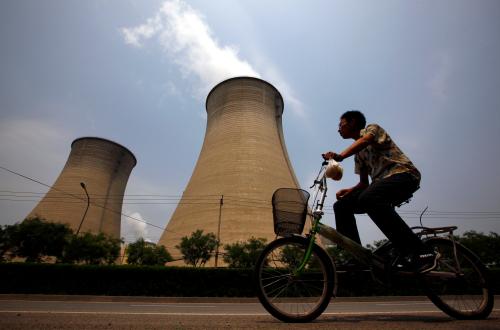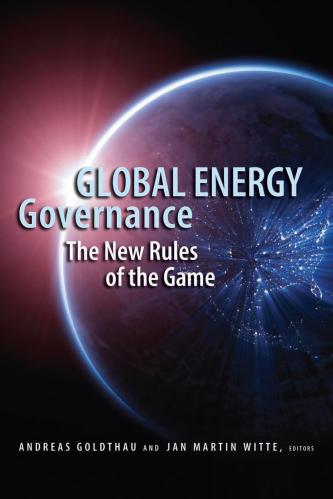The scalding report of the Iraq Inquiry, or Chilcot report, released this week about Tony Blair’s decision to support George W. Bush in his drive to invade Iraq showed how bad ideas can set off devastating trains of impacts that echo down the decades.
Blair was widely villainized in his country for putting the “special relationship” with the U.S. above much safer options of containment and multilateralism. But where did the U.S.’s “bad idea” come from?
Fifteen years ago this spring, the United States took a determinative turn when President George W. Bush, in his second week in office, created the National Energy Policy Development Group (NEPDG). The group was tasked with coming up with a solution on what to do about the U.S.’s heavy dependence on oil from the unstable Middle East.
The NEPDG never reconsidered U.S. or global dependence on petroleum. Instead, seeing a future of relentlessly increasing global demand for fossil fuels, the White House believed global oil production would have to increase dramatically by 2025 for the U.S. and the world to remain economically stable.
Looking back, one could argue that this “oil escalation” strategy failed on all counts, exacerbating instability in the Middle East and setting the U.S. and the world back a decade and a half in the fight against climate change.
Now, we face the retirement of aging coal and nuclear power plants, and a conjuncture where low oil prices are driving a new boom in the Middle East where extraction is the cheapest in the world, as just reported by the Internation Energy Agency. This is a pivotal moment in which we face a choice similar to the one that President Bush faced then: double down on what we know (fossil fuels) by building a new generation of natural gas wells, pipelines, and power plants to power our inefficient vehicles and buildings, or, make a decisive move toward renewables and efficiency.
Cheney’s Energy Doctrine
The Bush/Cheney chapter is illuminating in this context. Headed by Vice President Dick Cheney, the NEPDG issued a report—portentously called the National Energy Policy (the NEP)—only four months after Bush took office. Cheney and the NEPDG met with nearly 300 top energy industry officials, including 18 oil, mining, and gas associations, BP, and the vice president of Exxon Mobil. The NEPDG had just one meeting with environmental specialists, after the document was drafted.
Ominously declaring that “Energy security must be a priority of U.S. trade and foreign policy,” the NEP’s overarching goals were to increase global oil production, diversify our foreign oil suppliers, and clear away any economic and political obstacles that might get in the way of U.S. procurement of petroleum. This would, of course, keep the country dependent on foreign oil and the companies that sell it, but would hopefully improve national security by maintaining global economic stability and reducing U.S. dependence on any single foreign oil-producing nation.
The direction the NEPDG took our country in was not new, given that U.S. energy policy has committed the United States to heavy petroleum use since at least World War II, when the U.S. dramatically depleted its domestic oil supplies to win the war. President Franklin Roosevelt was so concerned about declining domestic oil reserves that he declared U.S. access to Saudi oil to be a vital national interest. The centrality of oil to U.S. national interests and strategic planning has been reaffirmed by every U.S. president since then. Presidents Harry Truman, Dwight Eisenhower, Richard Nixon, and Jimmy Carter, for example, all developed geopolitical doctrines designed either wholly or in part to protect U.S. oil interests in the Middle East, with each of these presidents pledging extensive military aid and training to U.S. allies in the region. Presidents Truman, Eisenhower, and Carter warned potential enemies that the U.S. was willing to use military force to protect its regional interests.
But by 2001, when George W. Bush took office, there was scientific consensus on the seriousness of climate change, ample evidence of the perils of petro-politics, and nearly two decades of experience with renewable and energy efficiency technologies. So President Bush’s decision to maintain our dependence on petroleum and to continue viewing access to oil as a top national security issue did not just set in train a series of events that resulted in the U.S.-led war in Iraq—a war that took a million lives, ran up over a trillion in U.S. national debt, led to the rise of ISIS, and forced millions of people from their homes, destabilizing the region. It also kept the United States, the world’s largest historical emitter of greenhouse gases, from reducing its greenhouse gas emissions. As a result, U.S. emissions increased until the Great Recession of 2008, with fossil fuel emissions relatively stable since then.
Needed: A Truly New National Energy Policy
Because greenhouse gases accumulate and persist in the atmosphere, solving the climate change crisis becomes increasingly difficult every year that we fail to seriously reduce our fossil fuel consumption. It is therefore important to remember and learn from such a key moment in history when our political and economic leaders had an opportunity to join Japan and Europe in turning sharply toward efficiency, conservation and renewable energy, or to double down on fossil fuels. Unfortunately, the Bush administration made a devastating choice: rather than leading the world to a greener future, the Bush White House set the U.S. and the world back 15 years in their attempts to rein in the climate crisis.
Today, a whole generation of coal and nuclear power stations is closing, and we face a stark choice. Like Bush and Cheney and the NEPDG, we can buy into the argument that fossil fuels are irreplaceable and that natural gas-fired power stations are a critical “bridge” to a lower-carbon future. But if we accept this stance, each facility we build will lock us into decades more dependency and risk, pushing us past safe ecological limits without addressing the inevitable transformation that the science of global warming suggests we have to make to reach zero net emissions in startlingly few years. Low priced Middle East oil is making this transition more difficult as Americans buy SUVs and build inefficient homes, so ambitious federal policy is urgently required. We can develop a full, transparent, imaginative, and forward-looking new national energy policy that moves us to a zero net emissions future. Our decisions must fully weigh the trillions of dollars in costs that business as usual will entail: from using our military to maintain U.S. access to and control over oil, the price of rescuing and resettling climate refugees, and the soaring burden of rebuilding the world’s coastal cities on higher ground.
The Brookings Institution is committed to quality, independence, and impact.
We are supported by a diverse array of funders. In line with our values and policies, each Brookings publication represents the sole views of its author(s).











Commentary
When Bush and Cheney doubled down on fossil fuels: A fateful choice for the climate
July 7, 2016